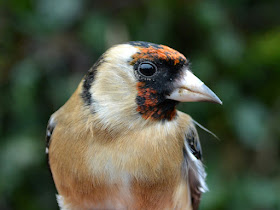 |
| At first glance it looked like a well marked female Blackbird. |
 |
| The tail was dark brown as you would expect for a female and the pointed shape of the tail feathers indicated that it was a first year bird. |
Over the years I have caught a good number of first year male Blackbirds that have had paler fringes to some of the body feathers giving them a quite scalloped appearance and some had quite pale throats but they were all basically black and obviously male. This male Blackbird certainly qualifies as the brownest and most female looking 'stockamsel' type that I have ever caught.
One 'stockamsel' type in the garden is quite interesting but this bird was actually the second I have caught recently. The previous one was caught in the garden just over a week ago, on 02/12/2016. It was just a little blacker than yesterday's bird and there was a bit more of a 'patchwork' appearance to the plumage as can be seen in the images below.
 |
| The feathers at the rear of the crown were blacker than you would expect on a female. |
 |
| The new charcoal-black greater coverts were the big giveaway that this bird is a male, if an odd looking one at that. |
So two 'stockamsel' types in a little over a week and if they weren't supposed to be birds of continental origin you could almost think they had come from the same nest. If you try and look for references to 'stockamsel' Blackbirds they are hard to come by but there is an illustration of one in BWP although it gets no further mention in the text. Stockamsel Blackbirds also get a mention in the Helm Guide to Bird Identification in the section on Ring Ouzels. There are a few others out there on the net and one that throws some light on the origin of the term can be found here.
The unusual plumages didn't end there and yesterday's garden catch also included a Goldfinch that had black feathers peppered throughout the red mask. I have caught thousands of Goldfinches over the years and never seen one like this before. Now I know it is not that dramatic as plumage variations go but I though it was interesting and worth sharing.
 |
| Almost half of the feathers that would normally be red were black in this individual. |
As for the ringing totals for 10/12/2016 I started the day off at Billinge where I caught 12 Redwings in the period around dawn. The catch would have been higher had it not been for the presence of a Sparrowhawk which spooked some groups of Redwings just as they were heading for the nets. When I got home I set a 6m net in the garden and, over the next 3 hours, caught (retraps in brackets): Goldcrest (1); Blue Tit 1; Blackbird 2; Goldfinch 19 (1).
The retrap Goldcrest had been ringed in the garden just over a year ago, on 26/11/2015 and the retrap Goldfinch was ringed in the garden almost 2 year ago to the day, on 12/12/2014.








No comments:
Post a Comment